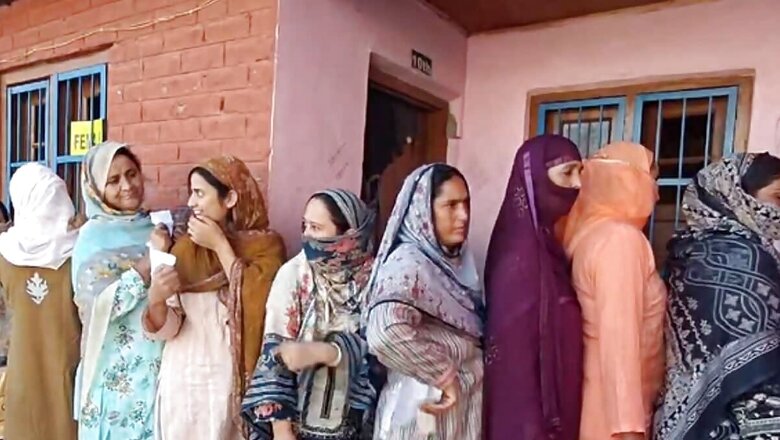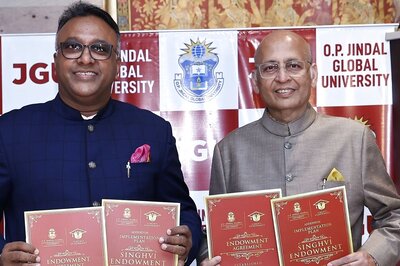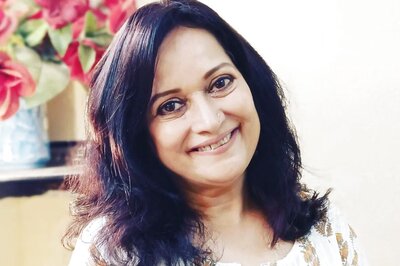
views
With voting wrapping up at 6pm on Saturday for the Haryana assembly elections, exit poll predictions for the state as well as Jammu & Kashmir have been announced. The three-phase elections for the 90 seats in Jammu & Kashmir concluded on October 1, marking the first assembly polls in the union territory since 2014.
J&K registered a voting percentage of 63.45 per cent, higher than the turnout recorded in the April-June Lok Sabha elections.
Dainik Bhaskar poll
According to the Dainik Bhaskar’s exit poll, the National Conference-Congress alliance could win 35-40 seats.
The BJP may end up with an impressive 20-25 seats. With 12-16 seats, independent candidates may surpass the PDP, which may get 4-7 seats.
Gulistan exit poll
The Gulistan exit poll predicts a much closer contest, with 31-36 seats for the NC-Congress combine and a stunning 28-30 for the BJP.
It also indicates a ‘kingmaker’ role for independent candidates who may end up with 19-23 seats and the PDP left with 5-7.
C-Voter Poll
This survey predicts 30-48 seats for the NC-Congress coalition, with BJP bagging 27-32.
The PDP may end up with 6-12 seats, on par with independents who could get 6-11 seats.
People’s Pulse Poll
The survey by People’s Pulse suggests the NC-Congress combine may emerge victorious with 46-50 seats, with the BJP bagging 23-27.
The PDP may get 7-11 seats and independents 6-10.
What politicians say
Former CM Omar Abdullah dismissed the exit polls for the Jammu and Kashmir assembly elections and said he will wait for October 8, when the results will be revealed. “I’m amazed channels are bothering with exit polls, especially after the fiasco of the recent general elections. I’m ignoring all the noise on channels, social media, WhatsApp Etc because the only numbers that matter will be revealed on the 8th of Oct. The rest is just time pass,” he wrote in a post on social media site X.
First assembly elections since 2014
These are the first elections held in the union territory since the abrogation of Article 370 sections. High-profile leaders, including Prime Minister Narendra Modi, union home minister Amit Shah, Lok Sabha leader of opposition Rahul Gandhi, and former J&K chief ministers Farooq Abdullah, Omar Abdullah, and Mehbooba Mufti, held extensive campaigning for weeks.
The National Conference (NC) and the Congress have formed an alliance for these elections, while the People’s Democratic Party (PDP) and the Bharatiya Janata Party (BJP) are among the other major contenders apart from some strong independent candidates.
What happened in 2014
During the 2014 assembly elections, pollsters like C-Voter predicted that the BJP would win between 27 and 33 seats, with the Congress securing 4 to 10 seats, the National Conference (NC) gaining 8 to 14 seats, and the People’s Democratic Party (PDP) projected to win 32 to 38 seats.
Ultimately, the PDP emerged as the largest party with 28 seats, while the BJP won 25, the NC secured 15, and the Congress finished with 12 seats.
What happened in 2008
In 2008, elections took place over seven days in November and December. The previous government, a coalition between the Jammu and Kashmir People’s Democratic Party (PDP) and the Congress, collapsed after the PDP withdrew its support.
Following the elections, the Jammu and Kashmir National Conference (NC) formed a coalition with the Congress, leading to Omar Abdullah becoming the state’s youngest chief minister at the age of 38.
That year, exit polls indicated that the National Conference was projected to win the majority of seats in the Valley, while the Congress was expected to secure the majority in the Jammu region.



















Comments
0 comment